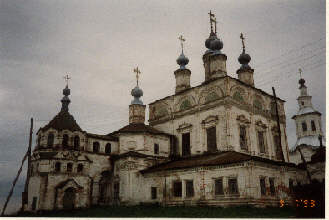| The first
mention of Viatka in the chronologies took place in 1374.
It was in this year that the Novgorod freebooters
undertook a campaign against the Volga Bulgarians, who
belonged to the Kingdom of the Golden Horde at the time.
After intial successes, the group broke up into two
parts. One of these groups travelled north and, according
to the chronology, plundered Viatka. Until today, it is
unclear whether the chronologist meant a specific
settlement or an entire region when he mentioned Viatka. Originally the region on the Viatka was
settled by Udmurtic tribes. In the late 12th century and
the early 13th century, Slavs also began to settle here.
Most of all, the region was colonized by Novgorod. Unlike
Novgorod, Viatka played a marginal role in the battles
for more territory and influences which took place among
the Russian nobles. It was far too distant to play any
crucial role and was also difficult to reach since it was
surrounded by dense forests and swamps. Nonetheless, the
territory changes ownership quite often: at one point, it
belonged to Susdal, then to Moscow, then again to the
Galician nobles. During this entire period, Viatka was
able to retain its political and administrative autonomy.
Like Novgorod, it was governed by a people's assembly
(vetshe).
In 1391, the Viatka region was
pillaged by the Mongols. Such attacks also took place
later, when the region was invaded by the Tartars who
lived around Kazan and in Siberia. These invasions
usually enjoyed the support of the tribal peoples of the
Mari and the Udmurts, the neighbours of the Russian
settlers.
The history of Viatka as a region
of political banishment began under Boris Godunov, who
had noisome followers and relatives of the later dynasty
of the Romanovs deported to Viatka. In the course of
time, many people shared their fate. The most famous of
these include the writers A. Herzen, M.
Saltikov-Shtshedrin and W. Korolenko. In the early 20th
century, the region became the goal for the forced
relocation of people from the Western provinces of the
Tsarist Empire such as Lithuanians, Latvians, Estonians,
Byelorussians and Poles.
Until today, the Viatka area is
known as an agrarian region; most of all, it is famous
for cattle-breeding and milk-products. Earlier,
honey-production, hunting and fishing existed next to
crop-production and cattle-breeding. During the late
17th/early 18th centuries, the first small metallurgical
enterprises were established. The region was also famous
for its artisans; most importanly, the carpenters enjoyed
a wide reputation.
During the Second World War, the
region and the town, renamed to Kirov in 1934, were a
part of the Soviet hinterland. Within a relatively short
period, a great number of armament factories were
established.
Today, the region's poor connection
to the infrastructure is one of its main problems: in
1985, there were as little as 12.6 km2 of paved roads for
1,000 km2 of surface area. This problem has had grave
demographic consequences. Between 1970 and 1985, the
rural population was reduced from 784,000 to 524,000.
Marion Krause
|

